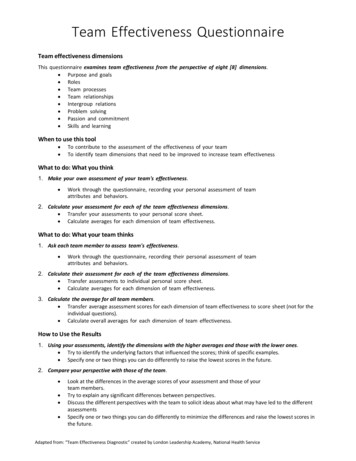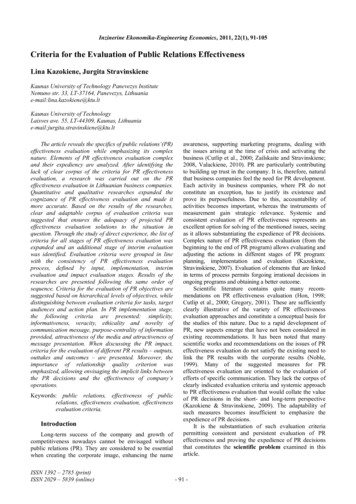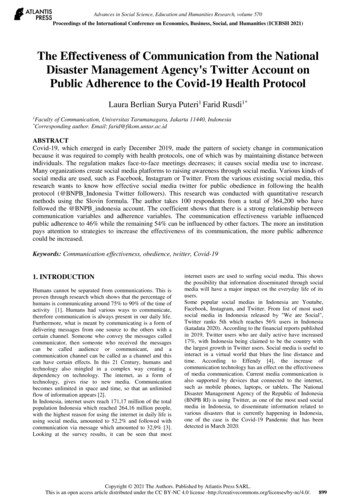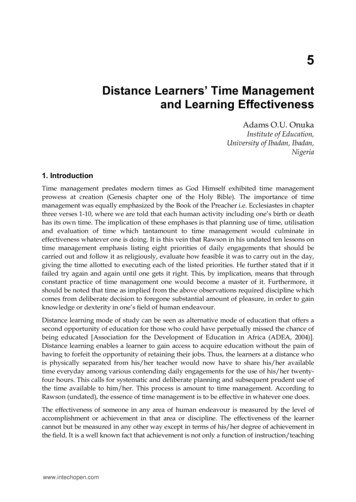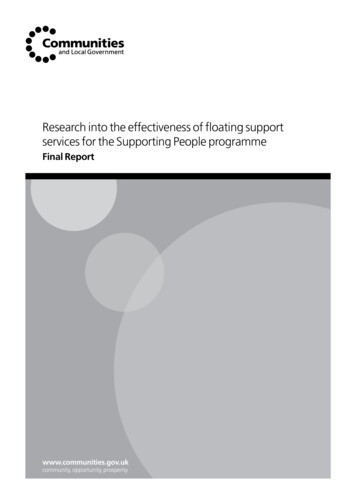
Transcription
Research into the effectiveness of floating supportservices for the Supporting People programmeFinal Reportwww.communities.gov.ukcommunity, opportunity, prosperity
Research into the effectiveness of floating supportservices for the Supporting People programmeFinal ReportCivis Policy Consulting ResearchApril 2008Department for Communities and Local Government
Communities and Local GovernmentEland HouseBressenden PlaceLondonSW1E 5DUTelephone: 020 7944 4400Website: www.communities.gov.uk Queen’s Printer and Controller of Her Majesty’s Stationery Office, 2008Copyright in the typographical arrangement rests with the Crown.This publication, excluding logos, may be reproduced free of charge in any format or medium for research, private studyor for internal circulation within an organisation. This is subject to it being reproduced accurately and notused in a misleading context. The material must be acknowledged as Crown copyright and the title of thepublication specified.Any other use of the contents of this publication would require a copyright licence. Please apply for a Click-Use Licencefor core material at , or by writing to the Office ofPublic Sector Information, Information Policy Team, St Clements House, 2-16 Colegate, Norwich, NR3 1BQ.Fax: 01603 723000 or email: HMSOlicensing@opsi.x.gsi.gov.ukIf you require this publication in an alternative format please email es and Local Government PublicationsPO Box 236WetherbyWest YorkshireLS23 7NBTel: 08701 226 236Fax: 08701 226 237Textphone: 08701 207 405Email: communities@capita.co.ukor online via the Communities and Local Government website: www.communities.gov.ukApril 2008Product Code: 07 HCS 05165
Contents 3ContentsExecutive summary 5Preamble 8Chapter 1: Introduction 9Chapter 2: Floating Support Services 12Chapter 3: The effectiveness of Floating Support Services 35Chapter 4: Accommodation based Services 48Chapter 5: B alance between Floating Support and Accommodation based Services60Chapter 6: The provision of other Services 69Chapter 7: Conclusions and Recommendations 75Appendix 1: Summary of Research specification and approach 79Appendix 2: Good Practice Action Points 82Appendix 3: Floating Support by Client Group and Region 85Appendix 4: Comparison of Platinum Cut data and SPLS extract 89Appendix 5: Bibliography and References 91Appendix 6: Glossary of Terms 93
Executive summary 5Executive summaryThe findings in this report are based on a short-term, secondary review of availableliterature and current practice undertaken by Civis for Communities and Local Governmentin September 2006.The researchers drew on a range of information, including a literatureand Administering Authorities (AA) documentation review, meetings with eight keystakeholders1, a questionnaire to Audit Commission Supporting People inspectors,telephone interviews with a sample of AAs and providers (covering a variety of clientgroups) and an analysis of Supporting People Local Services and Client Record data.Purpose of the reviewThe review was commissioned in order to better understand the effectiveness of floatingsupport services, and the balance needed between floating support and accommodationbased services in order to improve service delivery and choice and control for service users.Benefits of floating supportThe review found a number of benefits in providing floating support services.These aremainly focused on the delivery of flexible, person centred services to enable people toestablish and maintain independence in “ordinary” housing.Benefits identified included: This type of support can be provided to anyone who requires the supportirrespective of the type of accommodation in which they live. The separation of support from housing allows floating support workers to beadvocates for the service user and not representatives of the landlord. Services are flexible and can respond rapidly to crises or emergencies. People in isolated or rural areas can be provided with support in their own homes– services can have a greater “reach” than accommodation-based services. The level of support provided can be tailored to meet the needs of individuals andthe hours for individuals can be moved around. Floating support adopts a “holistic” approach to assessing an individual’s needsand acts as a focal point for brokering access to other services. It can be focused to meet strategic objectives, such as tackling homelessness(by sustaining accommodation), crime, anti-social behaviour and wider socialinclusion issues. Audit Commission, Homeless Link, Housing Corporation, National Housing Federation, National Women’s Aid, NIMHE, SCIE and Sitra.1
6 Research into the effectiveness of floating support services for the Supporting People programme: Final Report It can deliver health and social care outcomes including prevention of hospitalreadmissions, support through hospital discharge, reduction of substancemisuse, and prevention of institutional care. Positive outcomes for service users include improving quality of life, learningindependent living skills, accessing training/employment and improving health.Circumstances where the provision of floating support canface obstacles Some individuals may be reluctant or resistant to engage with support and otherservices, and a floating support approach may allow or provide opportunities fordisengagement. There are risks to be managed about the timing of support withdrawal – too earlycan lead to tenancy breakdown, too late may make the user dependent on theservice. Some individuals who require stabilisation may require more intensive on site or24-hour cover.Types of floating supportThe review found that all floating support services can be grouped under the broadheadings of generic or specialist services.In addition, it found that there is a specific type ofgeneric floating support service which solely focuses on crisis intervention work and thenmoves away. The review defined specialist services by the specialist knowledge of staff aswell as a higher intensity of support.The review concluded that all floating support services are, to a greater or less extent, multidisciplinary.It also concluded that all types of floating support services can carry out crisisintervention work, although generic crisis services move away once the crisis is resolved.Cost-effectiveness of floating supportThe researchers reported a considerable body of evidence about the cost effectiveness offloating support in terms of: Reducing rent arrears Prevention of tenancy breakdown and the resulting costs The reduction of hospital admissions (for people with mental health problems) The timely discharge of older people from hospital
Executive summary 7 The reduction of re-offending rates Addressing anti-social behaviour Preventing truancy costsAll of these outcomes reduce costs for public agencies, but also have wider social benefitsof helping to create sustainable communities and greater social cohesion.The balance between floating support and accommodationbased servicesThe debate about the balance between floating support and accommodation basedservices has tended to be framed in terms of the more floating support commissioned,the less accommodation based services will be available. This review showed that byre-commissioning existing floating support services it is possible to not only increase thecapacity of these services, but also provide much more focused and coherent services,without impacting on the level of accommodation based services.The researchers found a general consensus that an effective balance between floatingsupport and accommodation based services should be based on local circumstances, andresult from the strategic approach adopted by each authority to achieving the outcomesthey require. The authorities interviewed identified a number of factors that couldinfluence the right balance in each area, including: different strategic approaches to commissioning; local assessments of needs; the level of legacy floating support services; the scarcity of affordable housing within the authority; and whether the authority covered an urban or rural area.The review came to the conclusion that the balance between accommodation based andfloating support services should only be altered as part of a strategic approach to effectivelyaddress needs and achieve strategic outcomes. In particular authorities need to considerthe point at which people require access to services and how people can move throughservices.
8 Research into the effectiveness of floating support services for the Supporting People programme: Final ReportPreambleThis review is intended to provide Communities and Local Government with a betterunderstanding of floating support services, specifically in achieving the aims of theSupporting People programme. A summary of the research aims and the approachadopted is shown in Appendix 1.The definition of floating support for the research is ‘support services which are not tied tothe accommodation’. For the purpose of this review this means support that either: floats off to another service user when the support is no longer required, (usuallycrisis intervention or short term work); or follows the individual as the service user moves through different types ofaccommodation (usually long term support).This review is not intended to provide a definitive statement about what is meant bythe term floating support, or its boundaries with other types of services. However thedefinitions used above were understood by most of the participants and were consideredsufficiently universal to encompass the majority of floating support services.The report is structured to address the key research questions, particularly in relation to theeffectiveness of floating support services and the appropriate balance between these typesof services and accommodation based services. Appendix 2 draws out a number of actionpoints in relation to good practice in delivering floating support services. A glossary ofterms is shown in Appendix 6.Throughout the report there are a number of illustrative examples. These examples areintended to illustrate the issues raised in the text and are not intended to illustrate goodpractice.
Chapter 1 Introduction 9Chapter 1:Introduction1.1 IntroductionThe Supporting People programme was launched in April 2003 and aims to providehousing related support services to help vulnerable people live independently intheir home and prevent problems that can lead to hospitalisation, institutional careor homelessness. The programme is also intended to help with the transition toindependent living for those leaving hospital and institutions such as prisons.The Supporting People programme is administered by 150 Administering Authoritiesthat are responsible for delivering the programme at a local authority level includingdeveloping Supporting People strategies, working in partnership with otherstakeholders, commissioning support services and monitoring the quality andperformance of the services. The majority of support services commissioned underthe programme are either accommodation based services, where the support islinked to the accommodation, or floating support services.One of the main reasons for this review was the considerable amount of recommissioning activity involving floating support services. There have been someconcerns that the growth of floating support, in particular generic services, has beenfunding led rather than strategically led. It is therefore useful to look at the context tothe growth in floating support services over the past decade, to set the scene for thisreview.1.2 The growth of floating supportThe growth of floating support services was first stimulated by a number of newservice initiatives in the 1990’s, which created considerable interest in these types ofservices as an alternative way of providing support to vulnerable people. Some of thefloating support services were developed as local initiatives led by providers, whileothers involved a strategic multi-agency approach (CVS 1997).The Housing Corporation’s decision in 1991 to allow housing associations to bidfor revenue only funding (using Supported Housing Management Grant) providedconsiderable impetus to the development of floating support services. Thisprogramme meant that housing related support could be provided to people living in
10 Research into the effectiveness of floating support services for the Supporting People programme: Final Reportordinary housing association units and, instead of developing accommodation basedsupport services, housing associations had the option of developing floating support.Several events in the mid 1990’s contributed to the development of SupportingPeople, the main catalyst being a high court judgement confirming that restrictionson housing benefit to cover counselling and support services were lawful. As aconsequence the government introduced a Transitional Housing Benefit (THB)scheme to protect existing supported housing service users until an alternativepermanent solution could be found.In 1999 the government announced that it would introduce the Supporting Peopleprogramme from April 2003, with support funding drawn together into a single potto be administered by local authorities. A new THB scheme was introduced in therun up to April 2003, the costs of which rose considerably during this period. Therewere a number of reasons for this increase, including the costs of new services tomeet new policies e.g. homelessness prevention and the implementation of ValuingPeople (Audit Commission 2005). As floating support could be developed overa relatively short timescale it became the main model for delivering new supportservices.In September 1999 there were 2,435 units of floating support services funded underthe Housing Corporation’s SHMG funding framework, over 40 per cent of whichwere for people for mental health problems (a unit of floating support is defined as aservice user household). In April 2003 there were 106,892 units of floating support,with the main client group being people with generic needs (27%). Over a very shortperiod of time there had been a substantial increase in these types of services.Timeline1991Housing Corporation began funding floating support services usingSHMG1997High court decision on the use of housing benefit for counselling andsupport services. Introduction of Transitional Housing Benefit1999Government announcement of the introduction of SupportingPeople and the introduction of a new THB scheme for the period up toApril 20032003The introduction of the Supporting People programme on 1st April2003
Chapter 1 Introduction 111.3 Floating support under Supporting PeopleThe introduction of the Supporting People programme led Administering Authoritiesto re-appraise their legacy funded services to assess whether they were strategicallyrelevant and appropriate for meeting the needs of service users. In particular legacyfunded floating support services had a number of limitations, including the type oftenure on which THB could be claimed. Furthermore, the way in which support wasprovided usually meant that individual housing associations only provided supportto their own tenants and there was an uneven approach to the way in which theseservices were being provided.The introduction of the Supporting People programme led authorities to questionwhether legacy funded floating support services were appropriate to achievingtheir corporate strategies. Authorities have been through a process of re-evaluatingthese services using the quality and monitoring tools supplied by Communities andLocal Government, and many have decided to re-commission their floating supportservices. This report mainly concentrates on examining the re-commissioning offloating support services by those authorities that have already undertaken thisexercise or are in the process of doing so.
12 Research into the effectiveness of floating support services for the Supporting People programme: Final ReportChapter 2:Floating Support Services2.1 IntroductionThis research has found a general perception amongst some of the strategicstakeholders that the commissioning of generic floating support is largely driven byfinancial expediency. Commissioning floating support services is perceived as theprimary method used by authorities to deal with a reducing budget, at the expense ofaccommodation based services. Furthermore, as authorities are able to commissiona lower level of support input, immediate savings can be made irrespective of theoutcomes that they may want to achieve.However, the reseach also found that the sample of Administering Authoritiesinterviewed have re-commissioned their floating support services to more effectivelyachieve their strategic objectives. Rather than decommissioning accommodationbased services, in favour of floating support, these authorities have focused onrationalising their existing floating support contracts to increase capacity andimprove coverage.Discussions with the Audit Commission, and other strategic agencies, indicate thatsome Administering Authorities are driven by financial expediency and may not havelinked the commissioning of floating support to the outcomes they want to achieve.The sample of Administering Authorities interviewed for this review was selected tohighlight good practice and may not present a typical picture.2.2 Strategic approach to commissioning floating supportOne of the key issues the review wanted to examine was whether there was astrategic approach to commissioning floating support services and whether theauthorities were clear about the outcomes they wanted to achieve. Of thoseauthorities that had re-commissioned floating support services, the review foundthat all had adopted a strategic approach to achieving key corporate outcomesincluding: preventing homelessness i.e. reducing evictions; reducing crime e.g. by working with those involved in anti-social behaviour; increasing social inclusion e.g. by providing access to mainstream services;
Chapter 2 Floating Support Services 13 providing support to homelessness applicants and make savings to related costssuch as reducing school exclusions.The review also found that a number of authorities had carried out some strategicthinking about visiting support and were either in the process of re-commissioningthese services as floating support, or reviewing how these services could be providedwithin an overall pattern of service provision to vulnerable people.The cross authority strategies of some Administering Authorities have provided aframework for thinking about sub-regional commissioning. The West London groupof authorities is in the process of jointly commissioning a cross authority floatingsupport service for single homeless people and Southampton, Portsmouth andHampshire may commission a sub-regional floating support service for offenders.2.2.1 Key Drivers for developing floating supportIn addition to the strategic objectives identified, the review found the following werekey drivers for commissioning floating support.Rationalising legacy provisionAll the authorities involved in commissioning floating support had inherited apatchwork of floating support services as result of legacy arrangements. Someof these services were long established, while others had been pulled together totake advantage of THB funding prior to the introduction of the Supporting Peopleprogramme. Therefore, many of the authorities interviewed wanted to reconfigureexisting floating support services to more effectively meet their strategic objectivesand to reduce the number of contracts where similar services were provided.Example – Cornwall County CouncilCornwall reviewed their floating support services under the auspices ofCommunities and Local Government’s Value Improvement Programme. Thecouncil found that they had 49 different floating support services in the countyand as a consequence started a process of rationalising contracts and services.The county has produced a service specification for a new floating supportservice that will be split into three geographical areas to cover the whole county.All clients requiring floating support will be served through the services providedunder the three contracts. Cornwall envisages that the services will be deliveredthrough partnerships or consortia with one umbrella organisation managing theoverall contract/s. The county considers these services to be multi-disciplinary,with partnerships to deliver the specialisms within the overall zoned contracts.
14 Research into the effectiveness of floating support services for the Supporting People programme: Final ReportImproving coverageOne of the main reasons for re-commissioning support services has been to improvetheir coverage, particularly in rural areas. County councils, in particular, want servicesthat can respond to a variety of needs across the county. This issue has been themain driver for commissioning generic services, as they can respond immediatelyto the needs of individuals irrespective of the client group or the accommodation inwhich a person lives. The review has shown that often support is needed on housingand financial matters and swift intervention can prevent problems from escalating.Furthermore, one of the purposes of such services is to broker access to morespecialist services, where a client requires specific help.Providing more equitable accessThe re-commissioned floating support services involve a tenure neutral approachso that people living in private rented housing, social housing and owner occupiedaccommodation can access the service. Legacy floating support services ofteninvolved ring fencing services for people living in particular types of tenure, e.g. socialhousing, mainly because these tenancies could easily be linked to THB.The review found that authorities also want to create greater clarity of access forservice users, including developing single points of access or single ‘gateways’.A single point of access can replace the numerous access arrangements under legacyfunded services and as a result can provide more equitable access for service users.Some authorities have introduced open access arrangements (including self referrals)to ensure a rapid response.Example – Somerset County CouncilSomerset has commissioned a generic floating support service from Novas withcounty wide coverage. The service provides support for up to 650 service usersat any one time. Previously Somerset had a patchwork of floating support fordifferent client groups and has replaced them with a single generic service. Thereis a single gateway through Shelter which does the initial advice and screening.The main advantage of the generic service is that it is a more responsive andinclusive way of providing a support service – the service is tenure neutral andcan provide access to people living in rural areas and meet a diversity of needs.Furthermore there is less stigma attached to the service as users are not linked toa particular client group and the service can be provided in a person’s own home.
Chapter 2 Floating Support Services 152.2.2 Commissioning IssuesThere are a number of commissioning issues that have arisen from this review. Thisreview is not specifically required to address commissioning issues, but some of thesehave implications for the effectiveness of floating support services. These issues are asfollows:Service specifications for floating supportOne of the stakeholders made the point that a service should not be too tightlydefined as this could result in a less flexible approach to delivery. One of the mainadvantages of floating support is that it can respond flexibly to individual need and asa result the specifications for these services need to be broadly based and focused onoutcomes.Authorities differed in their approach to defining the volume of services required.Some required the volume of services to be specified in terms of the number ofhours and others required the number of units. Some authorities took the view thatspecifying the number of hours creates a much more flexible service as this involvesagreeing a target number of service users and allowing the provider to manage thecoverage of the service.ProvidersThe re-commissioning of generic floating support services has had a considerableimpact on the number of contracts for floating support services. Authorities havetended to roll together a number of existing floating support contracts into one, twoor three contracts for generic services.The review involved discussions with authorities about the impact of this approachon providers and found the following: A London authority pointed out that although this process has reduced thevolume of services provided by some providers, most of the providers are stillrunning other types of services; A county authority pointed out that larger organisations have the capacity todeliver large contracts and they intend to use smaller organisations to deliverspecialist services and services for high risk groups; A unitary authority explained that although it is rationalising the number ofcontracts for floating support the process will not necessarily rationalise thenumber of providers as many are creating consortia.It is clear, though, that where floating support services have been re-commissionedthere has been a rationalisation of those providers delivering this type of service. Oneauthority explained that they did not set out to reduce the number of providers, butthe tender process resulted in a “massive shake up”. Other authorities explained that
16 Research into the effectiveness of floating support services for the Supporting People programme: Final Reportthey intend to award some of the large floating support contracts to partnerships orconsortia – probably with one umbrella organisation managing the overall contractand other partners delivering specific elements. Voluntary sector organisations aremore likely to be sub-contracted under this arrangement, unless a large voluntarysector provider leads the partnership.Although a reduction in the number of providers was highlighted as potentiallyreducing choice from a service user point of view, the issue of choice may be morerelated to the way in which the service is provided (i.e. having a ‘say’), for instance thefrequency of visits, the options available and the extent to which the support plan isperson centred.SavingsThe issue of savings was discussed with the authorities and it is clear that, for some,the commissioning process has resulted in savings compared to the cost of theprevious floating support contracts. These savings have either been re-investedin increasing the capacity of the new floating support service, or have made acontribution to the overall Supporting People budget reductions.The interesting point is that none of the authorities involved in re-commissioningfloating support services identified the need to make savings as the main driver forcommissioning floating support. Some authorities recognised that floating supportgives them a more flexible commissioning model for the future, as these servicescould be de-commissioned should substantial reductions to their budgets berequired.Administrative savings have also resulted from the re-commissioning of floatingsupport, for example one authority will manage 3 contracts for a county widefloating support service instead of the 66 existing contracts. This will provide forgreater efficiencies in terms of monitoring the quality and performance of theseservices.Costing the serviceThe authorities involved in the review pointed out that the contracts for legacyfloating support services showed a huge variation in the prices paid for these services.The vagaries of THB meant that the services were costed in different ways and therewas no consistency between similar services. An analysis of the contracts for floatingsupport services by one of the authorities showed the following: The hourly rate for all floating support services ranged from 4.00 per hour to 62.90 per hour. The average hourly rate was 22.46. The median (midpoint) hourly rate was 19.78.
Chapter 2 Floating Support Services 17 Providers that had more than one service charged different rates for each service.This includes services which related to similar client groups in similar areas. The average hourly rate charged by providers, ranged from 10 per hour to 51.44 per hour. The contract price per unit per week ranged from 3.05 per unit to 163.44 perunit.As part of the rationalisation process authorities wanted to obtain consistentprices for similar services, based on a service specification for floating support. Thisapproach can provide a more transparent method for pricing services against specificexpectations around quality and outcomes.The most common method for tendering floating support services has been onthe basis of an hourly rate for support. This approach allows providers to define thenumber of hours of support that can be provided for a given contract sum. Otherapproaches have involved the unit cost of providing floating support, with the costsbroken down between staffing and overheads.The SPLS data for February 2006 shows that on average floating support servicesprovide about 3.3 hours of support per unit per week for front line staff and 0.61hours for direct managers of front line staff. This works out at an average hourly rateof approximately 28 for floating support, which is higher than the hourly rate forthose services that have been re-commissioned (in one example an hourly rate of 21 was awarded).There is an issue about defining what an hour of support should cover, in particularthe proportion of contact time with service users, and related follow up workcompared, with th
The growth of floating support services was first stimulated by a number of new service initiatives in the 1990's, which created considerable interest in these types of services as an alternative way of providing support to vulnerable people. Some of the floating support services were developed as local initiatives led by providers, while




